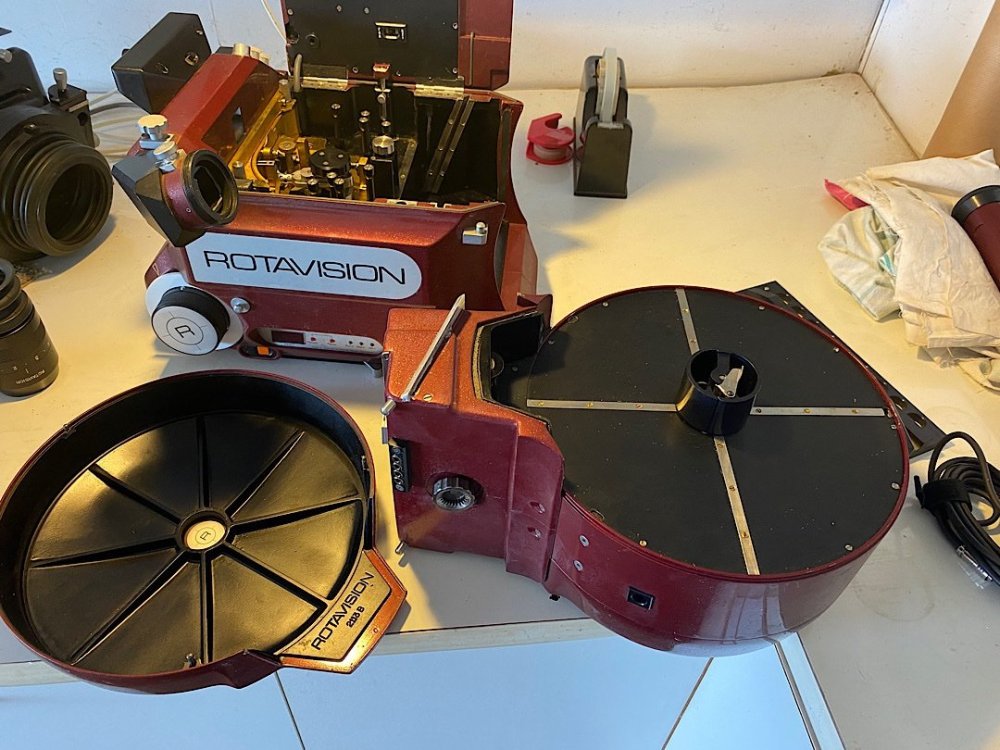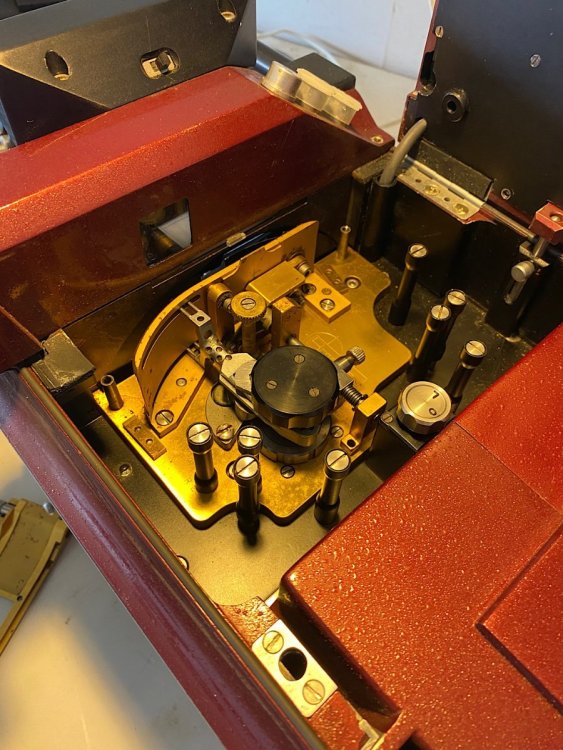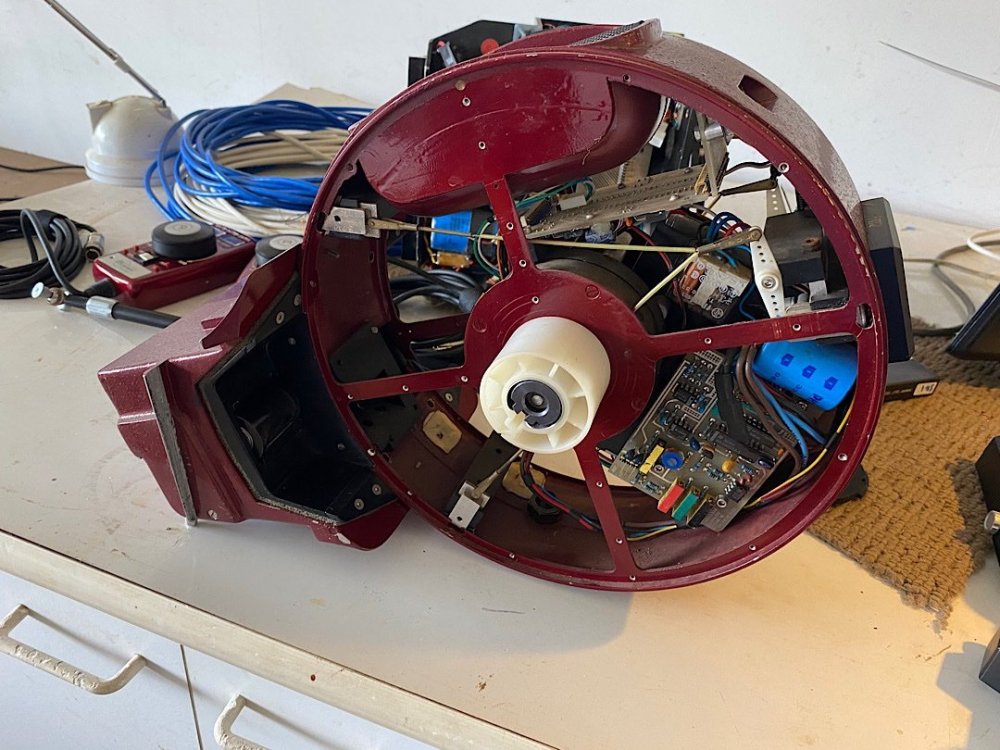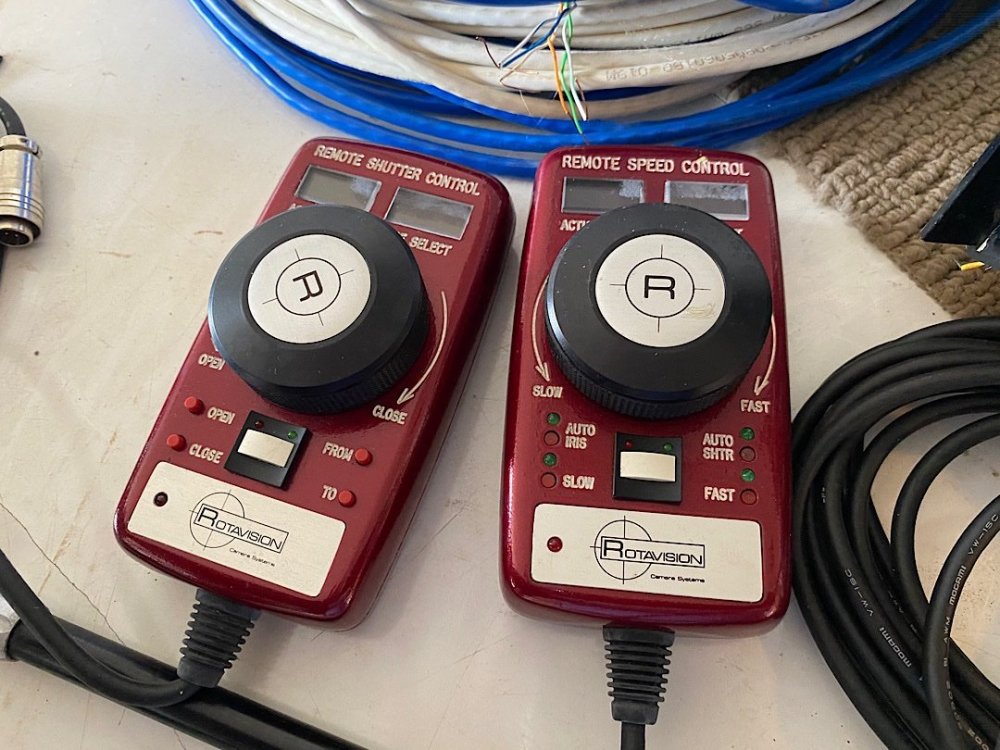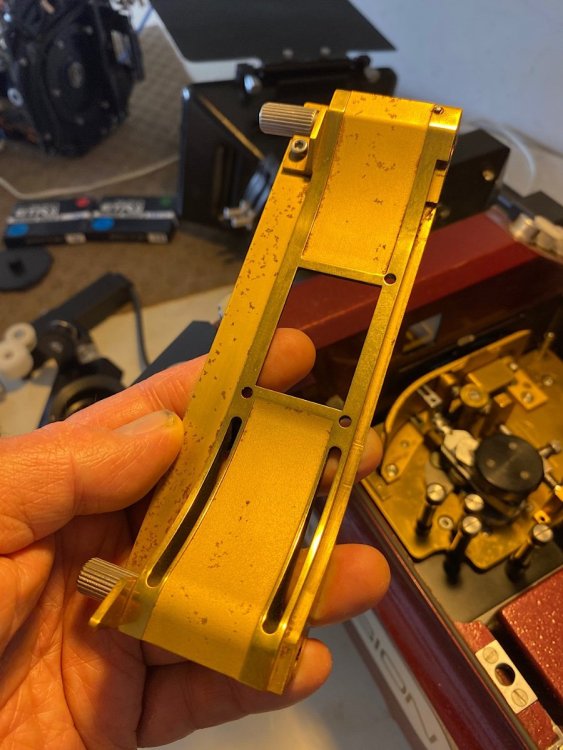-
Posts
3,518 -
Joined
-
Last visited
Everything posted by Dom Jaeger
-
Here's a thread where we talked about some of the many movies shot primarily on an Arriflex IIC:
-
I think it would be way more than that. I would say Arri have been a dominant player in the film industry for a lot longer than since 1990, probably since at least the 70s, particularly in countries outside the US. Panavision never really penetrated the European market, and was often too expensive for many other parts of the world. Mitchell were the dominant camera company globally from probably the 30s until the 70s, but in Europe particularly, IICs were very often used on lower budget and New Wave films, sometimes blimped. Often a IIC was used for the handheld or action shots in conjunction with a Mitchell. There's also the Techniscope films shot with modified IIcs, the Pan-Arris used in conjunction with Panavision lenses, and plenty of films from Asia or India or other parts of the world. The American New Wave started with films shot on Arri IIcs like Bullit and Easy Rider and by the 70s IIcs and 35 BLs were used on a multitude of films - think Scorcese or Kubrick or Bergman or Truffaut or Boorman etc. By the 80s, almost everything not shot with Panavision (and I'd say a majority of European cinema) was Arri. Moviecam made a dent in the duopoly in the 90s but were subsequently bough by Arri to produce the Arricam line. There's also the legacy of Arri's 1937 shutter/mirror design, which ended up as the primary reflex system utilised by motion picture cameras from the 70s to the 2000s, not to mention the various Arri designs that have become standards in cinematography like the PL mount since 1982. And in the 16mm world Arri have been the field leaders since the 16St was released in 1952. So yeah, maybe not 100 years, but at least a good 50! In the pantheon of cinema camera companies since the birth of cinema I would probably rank them Mitchell, Arri, Panavision, Debrie, Bell & Howell.
-
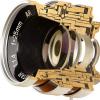
Best modern lenses for Super 16mm
Dom Jaeger replied to Mohammed Tahir's topic in Lenses & Lens Accessories
We had an Optex 5.5mm at the last rental house I worked at, which was a pretty good super wide angle I recall. -
Oh wow! Congratulations on a stellar career, Greg! I wish you all the best for the next phase of your life.
-

Best modern lenses for Super 16mm
Dom Jaeger replied to Mohammed Tahir's topic in Lenses & Lens Accessories
Ultra 16s, Cooke SK4s and the odd wide angle by Optex and Century were about as good as it got with S16 primes. But the enduring appeal of Zeiss Super Speeds (S16 ones) is not to be dismissed. Optar Illuminates and Elites were also not bad, approaching Super Speed quality. Many S16 lens sets were intended to be filled out with 35mm lenses for longer focal lengths. Lots of good zooms were made for S16 too. The Canons (8-64, 7-63, 6-66 etc), or Cookes (10.4-52 or 10-30) or Zeiss 11-110 or Angenieux 7-81, 11.5-138 were all good in various ways. -
There are lots of normal C mounts that will work fine with a non-reflex Bolex or other C mount cameras. Often buying a camera with lenses included is much cheaper than trying to source lenses individually. The price of C mounts has certainly become ridiculous, but occasionally you can get a bargain - typically if it's an auction rather than a buy it now price. Kern made a range of normal C mounts for non-reflex Bolexes and other C mount cameras, which are good quality. Switars were the premium range, Yvars were a bit simpler and cheaper. Look for ones that have AR written on them rather than RX or Macro-Switar. Schneider also made good C mounts, as did Taylor Hobson (Cooke), Angenieux, Elgeet, Kinoptik, Kodak and others. Som Berthiot made lower cost lenses, but some were still quite good. Really vintage, pre-war lenses by the likes of Taylor Hobson or Hugo Meyer or Goertz or Dallmeyer or Ross etc can be OK but older lenses can be lower contrast and deteriorated by time. Japan made lots of excellent cine C mounts from the late 50s on - Canon, Nikon, Kowa, Soligor etc, and then quite a few TV or CCTV lenses by Canon, Fujinon, Kowa, Computar, Cosmicar etc, which were generally made to lower specs than Cine. Some TV lenses are fine, some are pretty crappy but they tend to be cheaper. You can also adapt to many other lens mounts using adapters. This guy did a comparison of a bunch of C mounts: https://toby-marshall.com/galleries/bokeh-tales/a-comparison-of-the-bokeh-and-rendering-of-17-25mm-c-mount-16mm-cine-lenses/
-

Smudge/dark spots in my picture - what is the best way to fix this?
Dom Jaeger replied to Lucas Xavier Simes's topic in 16mm
Because fungus etching is just a lack of coating. Usually you need something actually obstructing light in order to be visible. Enough loss of coating and you will get light scattering causing loss of contrast and veiling glare, but I've never seen fungus etching photograph. Just like you won't see fine coating scratches in an image. But specks, smudges and blobs of residue can show up as shadows. -

Smudge/dark spots in my picture - what is the best way to fix this?
Dom Jaeger replied to Lucas Xavier Simes's topic in 16mm
I’m talking about the fungus stains, the etched “shadows” of the fungus. Those won’t photograph. The spots and spatters of whatever else was on there are definitely what you see in the film, and need to be cleaned off. -

Smudge/dark spots in my picture - what is the best way to fix this?
Dom Jaeger replied to Lucas Xavier Simes's topic in 16mm
Fungus can etch into the coatings of lenses and prisms. It usually happens if the fungus is left for some time. Keeping the Bolex prism clean is quite important, especially the inside surface which is closer to the film plane. The prism can be carefully flipped out when the turret is rotated out of the way, to access the back surface. Fungus stains should not show on the film though, they are just coating damage which tends to cause slight loss of contrast if anything. Whoever did the CLA should have noted the fungus, unless it happened since. Fungus grows when things are stored in dark, damp or humid places. The spots on the film will be from something else spattered on the prism, hopefully you have now cleaned them off. -
Yes, as I described earlier, if the front has been removed the light seal needs to be re-applied. If someone is claiming to be able to service or convert a Bolex but doesn’t re-apply the light seal, they are to be avoided. The seal should also fill the gap between the compartment and the camera body, which breaks if the mechanism is removed.
-
I have at least 10 clients from Queensland whose film cameras I’ve serviced over the years, probably more if I counted, so there are definitely filmmakers up there shooting on film. Not sure how you connect with them though. It’s a big state too, some are from far north, but most are Gold Coast/Brisbane based.
-
While I love film and film technology, and have invested a large portion of my life learning the mechanical intricacies of analogue cameras, I'm of the opinion that you can make art from anything. The important thing is the talent and the passion of the artist. I used to look down on photographers a little, having studied drawing and painting, which I considered a truer and more superior art form. Closer to the hand of the artist, no technology interpreting things, nothing smoothing out the individual quirks of a singular human vision. But great photography and cinematography pretty quickly disabused me of that notion. I still looked down a little on digital artists, who used programs to draw and colour their work. But watching my daughter master drawing on a tablet made me realise that her creativity still shone through, despite the pixels and program limitations. I play a bit of guitar and some players are utterly gear fixated - they have their valve amps and vintage guitars and know exactly how to achieve the sound they want. Then there are those who can pick up any old piece of crap instrument and make it sing. Having recently watched the Dylan biopic, I'm also reminded of the furor that erupted when he went electric at the Newport Folk Festival, and how quaint and silly that seems in hindsight. I guess my point is that being fanatical about a medium is kind of pointless. Use the medium you love and let the work make the argument. If it inspires someone else to try film, or play a Fender or paint with watercolours, then the medium lives on. I think there are some fabulous movies and series that have been shot digitally in the last decade, and as long as film is still an option I have no problem with it. The death of art I'm utterly against right now is AI, which takes all agency away from humans and steals from actual artists. Compared to that, shooting on a digital camera versus film seems a very minor disagreement.
-
There was the odd film shot digitally before the 2000s but nothing particularly noteworthy until after Sony released the F900, spurred on by George Lucas, who wanted to pioneer the use of digital cameras for cinema. I was working at Panavision Sydney in 2001 when we supported the Attack Of The Clones shoot at Sydney's Fox Studios and remember the hullabaloo over the new Panavised cameras and lenses. We spent a considerable amount of time making accessories and cables for that thing, and dealing with issues with the new workflow. Another notable film shot digitally in 2001 I recall was Russian Ark, shot in one take in the Hermitage Museum. It hadn't been possible to shoot an 87 minute take before. The Panavised F900 led to the creation of the Genesis a few years later, which shot some great looking movies like Apocolypto in 2006, and films like Avatar and Slumdog Millionaire in 2009 certainly proved that digital cinema could be wildly successful, but film was still by far the more popular medium until Arri released the Alexa in 2010. By 2013 digital had overtaken film, and by 2016 film was a niche format, with less than 10% of movies shot on film.
-
Separation of the beamsplitter prism can occur, but you can also see the prism join at certain angles, so it might be totally normal. A photo or two would certainly help. The ultimate test is what you get on the film. I’ve seen all sorts of issues with optics that seem awful but barely affect the image. Is the viewfinder image centered and complete? Sometimes if the right angle prism at the end of the viewfinder tube is not properly aligned the groundglass image can be offset and you might see reflections from outside the groundglass mask. But again, it’s hard to diagnose anything just from a verbal description.
-

K3 Needs CLA - Looking For European Technician
Dom Jaeger replied to Willem Jansen's topic in Russian Gear
Apart from the fact that there are numerous complaints about this guy from people who paid and never received a camera, if you do manage to get one the actual conversions are not very good. I was talking recently to the owner of a local scanning house and he told me 90% of the Max K3 footage he scans has issues. -
Thought this might be of interest to some of you. Jarin Blaschke & Dan Sasaki | Vintage & Custom Lenses
- 2 replies
-
- panavision
- vintage lenses
-
(and 1 more)
Tagged with:
-

K3 Needs CLA - Looking For European Technician
Dom Jaeger replied to Willem Jansen's topic in Russian Gear
What's wrong with it that makes you think it needs a service? If you just want to add some lubrication, clock oil or even sewing machine oil will do. Put a drop or two on the bearings where a shaft rotates. Don't oil gears, use a light grease or leave them dry. I don't think a K3 is worth paying for a professional overhaul by Du-All, particularly if you're in Europe. I was talking to the owner of a local scanning house recently and he told me nearly all the K3 footage he gets has issues of some sort, particularly the S16 ones. -
You should have no problems with focal lengths longer than 50mm, and even under that you will probably be OK unless you shoot at wide open apertures. When using heavy lenses you should definitely be using the bottom lens port locking screw to help keep the turret stable, but it doesn't really help with the top of the turret potentially deforming. As zooms became more prevalent, later Bolex models introduced a top lock for the turret, which helps with that. It's something that can be retro-fitted to earlier models like yours. It depends somewhat on just how heavy and long the lens in question is. Avoid transporting the camera with heavy lenses fitted, or subjecting the camera to bumps and knocks. I agree that the price for some C mount lenses has become rather ridiculous, but you should be able to find 3 to 6 inch teles for around $100. For example: https://www.ebay.com/itm/256875339492 https://www.ebay.com/itm/387268208684 https://www.ebay.com/itm/226182882613 https://www.ebay.com/itm/326255729161
-

problems calculating FoV with non-reflex Bolex H16M5
Dom Jaeger replied to Daniel Jewesbury's topic in Bolex
These are the times when any other Bolex model would be quite useful! But I think your calculations seem correct, so tell your far from foolish friend to give it a go and see! -
I must apologise, I didn't realise the seller has an MBA. The high price is therefore entirely justified.
-

Nolan to use new IMAX cameras on next film
Dom Jaeger replied to Stephen Perera's topic in General Discussion
If you read what I wrote, they were not designed to be quiet. VistaVision in the 90s was primarily used for effects shots or plates as Steve mentioned earlier, and the available cameras were pretty basic. The first camera Bruce made, for an exhibit at the Expo 88 Australian Pavilion, was very similar to the Beaumont cameras, a simple VistaVision butterfly design built around a Mitchell movement. Having successfully made and used that one, he decided to make a much better system. The Rotavision cameras were more like what Arri was concurrently designing with the 435 - a MOS effects camera with seperate shutter and drive motors, the ability to speed ramp while changing shutter angle via remote controllers, three registration pins for extra stability, an integrated video split. He also added integrated lens motors and all sorts of other features. I don’t think they were ever intended to be for sale, his idea was to rent them like Arri does with the 765 or Alexa 65 or the Panavision model. They were battle tested on multiple shoots here in Australia, including the Babe movies, Queen of the Damned, and various museum installations and exhibits. They didn’t manage to penetrate the US or EU markets very much in the time before the EPROM failed, and threw a spanner in the works. In the meantime Bruce was also making multi-format portable loop stations for people like Tacita Dean, developing 65mm cameras and motion control rigs, as well as doing many 2 perf and Super 16 conversions. I think if he had had more support and funding he could have redesigned the electronics in the Rotavision cameras, and perhaps even gone on to design a sync sound version, but it never happened, and within about ten years nobody was making film cameras anymore. -
Nobody in their right mind is paying $12K for a wind-up Bolex, even with a $500 zoom thrown in.
-

Nolan to use new IMAX cameras on next film
Dom Jaeger replied to Stephen Perera's topic in General Discussion
I visited Bruce McNaughton recently, and checked out his Rotavision cameras. Very far from vaporware, if anything I think they were perhaps over-engineered. Quite an incredible achievement really, he devised an entire VistaVision ecosystem - cameras, mags, integrated lens motors and controllers, matte boxes, rehoused lenses. Unfortunately his electronics designer made a poor choice and the E-prom heart of the electronics failed after five years, and the project faultered. He made six cameras in total. They were not quiet, designed mainly for plates and effects. They were used for certain shots in Babe 1 and 2, among other films. He showed me a photo from the Babe shoot, where they had the camera mounted sideways for a vertical shot that would allow panning down in post. He had to design a special mag that could run on its side for that shot. Here are some pics of one camera, and the guts of another. The movement is based on a Mitchell, but Bruce added a third registration pin for increased stability. An optics professor from Sydney Uni helped design the viewfinder optics, complete with a rotating pechan prism to keep the image horizontal while allowing the viewfinder to rotate. There is a butterfly mirror/shutter, with a second focal plane shutter allowing some shutter angle variation and single frame operation. The mags are co-axial, with a curling film path that moves the film from vertical to horizontal and back again, with a very clever gear system that drives all the sprockets. The mags contain a weight sensor that could detect how much film was loaded - a full roll or a short end - among many other features. The camera has an integrated manual follow focus as well as power and data connectors for custom lens motors, an idea well ahead of its time. The lenses are rehoused Zeiss Contax and Hasselblad, with a BNCR mount. The ground glasses were re-purposed from a stills camera, and slide in from the film chamber side.






